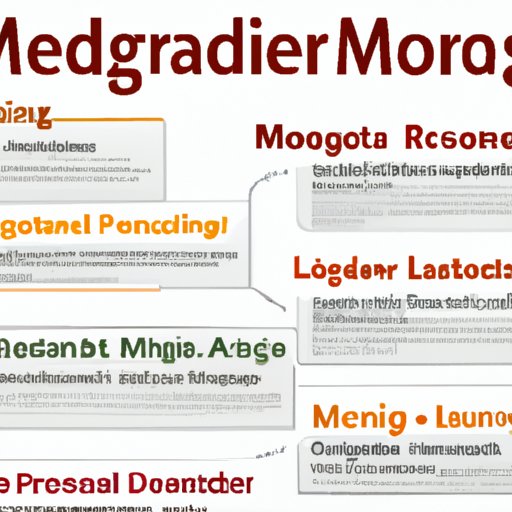Introduction
A mortgage is a loan that allows a borrower to use their home as collateral. It is one of the most common ways for people to purchase or refinance a home. The process of applying for a mortgage can be complicated, but understanding it is important for any homeowner. This article will provide a comprehensive overview of how mortgages work, from applying for a loan to refinancing.
A Step-by-Step Guide to Understanding How Mortgages Work
The process of applying for a mortgage and obtaining approval involves several steps. Knowing what to expect can help make the process smoother and less stressful.
Applying for a Mortgage
The first step in the mortgage process is to apply for a loan. You’ll need to provide information about your income, assets, employment history, and other financial details. The lender will review this information to determine if you are qualified to take out a loan.
Pre-Qualification and Credit Check
Once you’ve submitted your application, the lender will run a credit check to assess your creditworthiness. They may also require additional documents such as tax returns or bank statements. If you’re pre-qualified for a loan, the lender will give you an estimate of how much you can borrow.
Shopping for the Best Rates
Once you’ve been pre-approved, it’s time to shop around for the best rate. Compare the interest rates and fees offered by different lenders to find the best deal. You may also want to consider the terms of the loan, such as the length of the repayment period.
Submitting Documents
When you’ve found a lender and agreed on the terms of the loan, you’ll need to submit additional documents to finalize the loan. These documents may include proof of income, bank statements, and other financial information. The lender will then review the documents and make a decision.
Closing on the Loan
Once your loan has been approved, you’ll need to attend a closing. At the closing, you’ll sign the loan documents and pay any closing costs. Once the closing is complete, the lender will disburse the funds and you’ll officially become the owner of the property.
Exploring the Different Types of Mortgages and Their Benefits
There are several different types of mortgages available to borrowers. Each type offers its own advantages and disadvantages.
Fixed-Rate Mortgages
A fixed-rate mortgage is one of the most popular types of mortgages. It has an interest rate that remains the same throughout the life of the loan. This makes it easier to budget since your monthly payments won’t change over time. However, the interest rate may be higher than with other types of loans.
Adjustable-Rate Mortgages
An adjustable-rate mortgage (ARM) has an interest rate that can change over time. These loans typically have a lower initial interest rate, but the rate can increase over time based on market conditions. ARMs are a good option for borrowers who don’t plan to stay in the home for a long time.
Jumbo Mortgages
A jumbo mortgage is a loan that exceeds the maximum loan limit set by the Federal Housing Finance Agency. These loans often come with higher interest rates and stricter qualification requirements. They are typically used to finance more expensive homes.
FHA Mortgages
An FHA mortgage is a loan insured by the Federal Housing Administration. These loans are designed to help borrowers with lower incomes and credit scores qualify for a home loan. FHA loans typically require a smaller down payment than conventional loans and have more flexible qualification requirements.
VA Mortgages
A VA mortgage is a loan guaranteed by the Department of Veterans Affairs. These loans are designed to help eligible veterans and service members purchase a home. VA loans typically require no down payment and have more lenient qualification requirements than other types of loans.
USDA Mortgages
A USDA mortgage is a loan guaranteed by the United States Department of Agriculture. These loans are designed to help low-income borrowers purchase a home in rural areas. USDA loans typically require no down payment and have more flexible qualification requirements than other types of loans.

An Overview of Mortgage Lenders and Their Requirements
Mortgage loans can be obtained from various types of lenders. Each type of lender has its own set of requirements and loan terms.
Banks
Banks are traditional lenders that offer mortgages to creditworthy borrowers. Banks typically require a larger down payment and have stricter qualification standards than other types of lenders.
Credit Unions
Credit unions are non-profit financial institutions that offer mortgages to members. Credit unions generally offer more competitive rates and more flexible qualification requirements than banks.
Mortgage Brokers
Mortgage brokers are independent companies that act as intermediaries between borrowers and lenders. They can help you compare rates and terms from multiple lenders to find the best loan for your needs.
Online Lenders
Online lenders are digital lenders that offer mortgages online. These lenders typically have more flexible qualification requirements and faster approval times than traditional lenders.

The Pros and Cons of Taking Out a Mortgage
Taking out a mortgage can be a great way to buy a home, but it’s important to understand the potential risks and benefits. Here are some of the pros and cons of taking out a mortgage.
Advantages
One of the main advantages of taking out a mortgage is that it allows you to purchase a home without having to pay the full amount up front. Additionally, mortgage interest is usually tax deductible, which can save you money on your taxes. Finally, mortgages often come with fixed interest rates, making it easier to budget for your monthly payments.
Disadvantages
One of the main disadvantages of taking out a mortgage is that it requires you to take on a large amount of debt. Additionally, if you fail to make your payments, you could lose your home. Finally, mortgage loans typically have high interest rates, so you may end up paying more in interest over the life of the loan.

Tips for Getting Approved for a Mortgage Loan
Getting approved for a mortgage loan can be challenging, but there are some steps you can take to improve your chances. Here are some tips for getting approved for a mortgage loan.
Improve Your Credit Score
Your credit score plays an important role in determining whether you’ll be approved for a mortgage. Improving your credit score by paying bills on time and reducing your debt can help you get approved for a better loan.
Reduce Your Debt-to-Income Ratio
Your debt-to-income ratio is the amount of debt you have compared to your income. Lenders look at this ratio to determine how much of a risk you are. Reducing your debt can help improve your debt-to-income ratio and increase your chances of getting approved for a loan.
Have a Steady Source of Income
Lenders want to see that you have a steady source of income before approving a loan. Having a job or other reliable source of income can help improve your chances of getting approved for a loan.
Make a Large Down Payment
Making a large down payment can help you get approved for a loan. A larger down payment reduces the amount of money you need to borrow and can make you a more attractive borrower to lenders.
What You Need to Know About Refinancing a Mortgage
Refinancing a mortgage can be a great way to save money on your loan, but it’s important to understand the process before making a decision. Here’s what you need to know about refinancing a mortgage.
Reasons to Refinance
There are several reasons why you might want to consider refinancing your mortgage. For example, you may want to refinance to get a lower interest rate, switch from an adjustable-rate to a fixed-rate loan, or access equity in your home.
Factors to Consider
Before refinancing, it’s important to consider all the factors involved. Make sure you understand the terms of the new loan and calculate how much you’ll save in interest payments over the life of the loan. Additionally, keep in mind that refinancing comes with closing costs, so make sure you factor these into your calculations.
Cost of Refinancing
The cost of refinancing varies depending on the type of loan you choose and the fees associated with the loan. Closing costs typically range from 3-6% of the loan amount, so make sure you factor this into your decision.
The Basics of Mortgage Insurance and Its Advantages
Mortgage insurance is a type of insurance that covers the lender in case the borrower defaults on the loan. Here’s what you need to know about mortgage insurance and its advantages.
Types of Mortgage Insurance
There are two types of mortgage insurance: private mortgage insurance (PMI) and government mortgage insurance. PMI is typically required for conventional loans with down payments of less than 20%. Government mortgage insurance is typically required for FHA and VA loans.
Benefits of Mortgage Insurance
Mortgage insurance can be beneficial for borrowers who don’t have enough money saved for a down payment. It allows borrowers to get approved for a loan with less money down. Additionally, mortgage insurance can help protect the lender in case the borrower defaults on the loan.
Cost of Mortgage Insurance
The cost of mortgage insurance varies depending on the type of loan and the size of the down payment. Generally, the higher the down payment, the lower the cost of the mortgage insurance. Additionally, PMI premiums are typically paid monthly while government mortgage insurance is paid upfront.
Conclusion
Understanding how mortgages work is essential for any homeowner. This article has provided an in-depth look at the mortgage process, from applying for a loan to refinancing. It has also explored the different types of mortgages and their benefits, as well as the requirements of different lenders. Finally, it has discussed the pros and cons of taking out a mortgage and provided tips for getting approved for a loan.
(Note: Is this article not meeting your expectations? Do you have knowledge or insights to share? Unlock new opportunities and expand your reach by joining our authors team. Click Registration to join us and share your expertise with our readers.)
